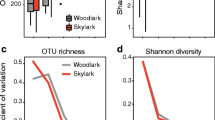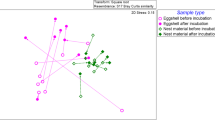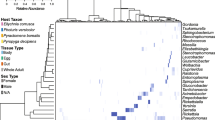Abstract
Microbial relationships between birds and nesting environments are complex and remain poorly understood. Past studies have focused on between-nest variation in egg/chick bacterial profiles with little attention given to the microbial relationships between adult birds and their nests. Moreover, very little microbial research has included mycology despite fungi being prevalent in nesting environments and important correlates of fitness in chicks. In this study, we identified microbes associated with feathers, skin and nests of Pied Flycatchers Ficedula hypoleuca, an internationally declining migrant songbird. From 75 samples, we isolated 50 bacterial Operational Taxonomic Units (OTUs; dominated by Enterococcus, Sanguibacter, Pseduomonas) and 63 fungal OTUs (dominated by Penicillium, Aspergillus), many of which had not previously been isolated from birds. Although females had significantly higher non-haemolytic bacterial OTU richness and males significantly higher fungal OTU richness, there was considerable diversity in actual OTUs isolated and thus there was no “typical” female, male or nest microbial profile. Interestingly though, we show for the first time that the microflora of individual females is significantly more similar the microflora of her own nest than the site-level average of all nests. This suggests microbes are shared within female-nest pairs such that microbial communities start to converge. This is probably a two-way interaction as gut/skin microbes were isolated from nests and plant/soil microbes were isolated from females. Convergence was not seen for males, which probably reflects the role of the female as sole nest builder and egg incubator in this species. We discuss these findings in relation to microbial transfer pathways and avian nesting behaviour.
Zusammenfassung
Ähnlichkeit der Mikrobiome von adulten weiblichen Trauerschnäppern und ihren Nestern
Mikrobielle Zusammenhänge zwischen Vögeln und Brut-umgebungen sind komplex und bis heute schlecht verstanden. Vergangene Untersuchungen waren konzentriert auf Unterschiede in bakteriellen Profilen von Eiern und Küken zwischen Nestern, mit nur geringer Aufmerksamkeit auf mikrobielle Zusammenhänge zwischen adulten Vögeln und ihren Nestern. Darüber hinaus erstreckten sich die mikrobiologischen Untersuchungen nur selten auf Pilze, obwohl diese in Brutumgebungen häufig anzutreffen sind und wichtige Korrelate darstellen für die Fitness der Küken. In dieser Untersuchung identifizierten wir Mikroorganismen von Federn, Haut und aus Nestern des Trauerschnäppers Ficedula hypoleuca, einem Singvogel, der international abnimmt. Aus 75 Proben isolierten wir 50 bakterielle OTUs (Operational Taxonomic Units; hauptsächlich Enterococccus, Sanguibacter, Pseudomonas) und 63 Pilz-OTUs (hauptsächlich Penicillium, Aspergillus), von denen viele bislang noch nicht bei Vögeln isoliert wurden. Obwohl Weibchen einen signifikant höheren nicht-hämolytisch bakteriellen OTU-Reichtum aufwiesen und Männchen einen signifikant höheren OTU-Reichtum an Pilzen, gab es wesentliche Unterschiede zwischen einzelnen OTUs, so dass man nicht von „typisch“weiblichen, männlichen oder Nest-OTUs sprechen kann. Interessanterweise können wir zum ersten Mal zeigen, dass die Mikroflora eines einzelnen Weibchens signifikant ähnlicher der Mikroflora ihres eigenen Nestes ist als dem Durchschnitt aller Nester im Untersuchungsgebiet. Dies legt nahe, dass Mikroorganismen zwischen Weibchen und Nest ausgetauscht werden, so dass die Mikrobiome anfangen zu konvergieren. Dabei handelt es sich wahrscheinlich um eine bidirektionale Interaktion, da Mikroorganismen aus dem Darm und von der Haut aus dem Nest isoliert wurden und Pflanzen- und Bodenmikroorganismen von den Vögeln. Eine Konvergenz der Mikrobiome konnte für Männchen nicht gezeigt werden, was vermutlich die Rolle der Weibchen dieser Art wiederspiegelt, allein für Nestbau und Brüten verantwortlich zu sein. Wir diskutieren diese Ergebnisse in Relation zu Übertragungswegen von Mikroorganismen und Brutverhalten von Vögeln.




Similar content being viewed by others
References
Archie EA, Theis KR (2011) Animal behaviour meets microbial ecology. Anim Behav 82:425–436
Berger S, Disko R, Gwinner H (2003) Bacteria in starling nests. J Ornithol 144:317–322
BIOLOG (2007) FF MicroPlate: instructions for use http://www.biolog.com/pdf/milit/00A%20010rB%20FF%20Sell%20Sheet%20Mar07.pdf. Accessed 1 June 2016
BIOLOG (2008) GEN III MicroPlate: instructions for use http://www.biolog.com/pdf/milit/00P%20185rA%20GEN%20III%20MicroPlate%20IFU%20Mar2008.pdf. Accessed 1 June 2016
Bojesen AM, Nielsen SRS, Bisgaard M (2003) Prevalence and transmission of haemolytic Gallibacterium species in chicken production systems with different biosecurity levels. Avian Pathol 32:503–510
Bordenstein SR, Theis KR (2015) Host biology in light of the microbiome: ten principles of holobionts and hologenomes. PLoS Biol 13:e1002226
Brandl HB, van Dongen WF, Darolová A, Krištofík J, Majtan J, Hoi H (2014) Composition of bacterial assemblages in different components of reed warbler nests and a possible role of egg incubation in pathogen regulation. PLoS One 9:e114861
Burtt EH (1999) Think small. Auk 116:878–881
Cook MI, Beissinger SR, Toranzos GA, Rodriguez RA, Arendt WJ (2003) Trans-shell infection by pathogenic micro-organisms reduces the shelf life of non-incubated bird’s eggs: a constraint on the onset of incubation? Proc R Soc B 270:2233–2240
Cook MI, Beissinger SR, Toranzos GA, Rodriguez RA, Arendt WJ (2005) Microbial infection affects egg viability and incubation behavior in a tropical passerine. Behav Ecol 16:30–36
Davies DL, Bouldin DW (1979) A cluster separation measure. Pattern analysis and machine intelligence. IEEE Trans 1:224–227
Dille JW, Rogers CM, Schneegurt MA (2016) Isolation and characterization of bacteria from the feathers of wild Dark-eyed Juncos (Junco hyemalis). Auk 133:155–167
Fernández-Garayzábal JF, Dominguez L, Pascual C, Jones D, Collins MD (1995) Phenotypic and phylogenetic characterization of some unknown coryneform bacteria isolated from bovine blood and milk: description of Sanguibacter gen. nov. Lett Appl Microbiol 20:69–75
Glare TR, Gartrell BD, Brookes JJ, Perrott JK (2013) Isolation and identification of Aspergillus spp. from brown kiwi (Apteryx mantelli) nocturnal houses in New Zealand. Avian Dis 58:16–24
González-Braojos S, Vela AI, Ruiz-De-Castañeda R, Briones V, Cantarero A, Moreno J (2012) Is nestling growth affected by nest reuse and skin bacteria in Pied Flycatchers Ficedula hypoleuca? Acta Ornithol 47:119–127
González-Braojos S, Vela AI, Ruiz-de-Castañeda R, Briones V, Cantarero A, Moreno J (2015) Bacteria on nestling skin in relation to growth in pied flycatchers. J Ornithol 156:327–330
Goodenough AE, Stallwood B (2010) Intraspecific variation and interspecific differences in the bacterial and fungal assemblages of Blue Tit (Cyanistes caeruleus) and Great Tit (Parus major) nests. Microbial Ecol 59:221–232
Goodenough AE, Stallwood B (2012) Differences in culturable microbial communities in bird nestboxes according to orientation and influences on offspring quality in great tits (Parus major). Microbial Ecol 63:986–995
Grizard S, Dini-Andreote F, Tieleman BI, Salles JF (2014) Dynamics of bacterial and fungal communities associated with eggshells during incubation. Ecol Evol 4:1140–1157
Hellström S, Kiviniemi K, Autio T, Korkeala H (2008) Listeria monocytogenes is common in wild birds in Helsinki region and genotypes are frequently similar with those found along the food chain. J Appl Microbiol 104:883–888
Hubálek Z (1978) Coincidence of fungal species associated with birds. Ecology 59:438–442
Hubálek Z (2000) Keratinophilic fungi associated with free-living mammals and birds. In: Kushwaha RKS, Guarro J (eds) Biology of dermatophytes and other keratinophilic fungi. Revista Iberoamericana de Micología, São Paulo, pp 93–103
Hubálek Z, Balát F (1976) Seasonal distribution of keratinolytic fungi in the nests of tree sparrow (Passer montanus L.). Zentralblatt für Bakteriologie, Parasitenkunde, Infektionskrankheiten und Hygiene. Zweite Naturwissenschaftliche Abteilung: Allgemeine, Landwirtschaftliche und Technische Mikrobiologie 131:179–197
Kilgas P, Saag P, Mägi M, Tilgar V, Mänd R (2012) Plumage bacterial load increases during nest-building in a passerine bird. J Ornithol 153:833–838
Klingler JM, Stowe RP, Obenhuber DC, Groves TO, Mishra SK, Pierson DL (1992) Evaluation of the Biolog automated microbial identification system. Appl Environl Microbiol 58:2089–2092
Konopka A, Oliver L, Turco RF (1998) The use of carbon substrate utilization patterns in environmental and ecological microbiology. Microbial Ecol 35:103–115
Lewis WB, Moore FR, Wang S (2016) Characterization of the gut microbiota of migratory passerines during stopover along the northern coast of the Gulf of Mexico. J Avian Biol. doi:10.1111/jav.00954
Lombardo MP, Thorpe PA, Cichewicz R, Henshaw M, Millard C, Steen C, Zeller TK (1996) Communities of cloacal bacteria in tree swallow families. Condor 89:167–172
Lucas FS, Heeb P (2005) Environmental factors shape cloacal bacterial assemblages in great tit Parus major and blue tit P. caeruleus nestlings. J Avian Biol 36:510–516
McFall-Ngai M, Hadfield MG, Bosch TC, Carey HV, Domazet-Lošo T, Douglas AE, Dubilier N, Eberl G, Fukami T, Gilbert SF, Hentschel U (2013) Animals in a bacterial world, a new imperative for the life sciences. Proc Natl Acad Sci 110:3229–3236
Mills TK, Lombardo MP, Thorpe PA (1999) Microbial colonization of the cloacae of nestling tree swallows. Auk 116:947–956
Moreno J, Briones V, Merino S, Ballesteros C, Sanz JJ, Tomás G (2003) Beneficial effects of cloacal bacteria on growth and fledging size in nestling pied flycatchers (Ficedula hypoleuca) in Spain. Auk 120:784–790
Moyers SC, Kosarski KB, Adelman JS, Hawley DM (2015) Interactions between social behaviour and the acute phase immune response in house finches. Behaviour 152:2039–2058
Nawrot R, Barylski J, Tomaszewski Ł, Jerzak L, GoŸdzicka-Józefiak A, Jêdrzejewski S (2009) Identification of bacterial species in white stork chicks in Poland using PCR method and sequencing of bacterial 16S rRNA. Pol J Environ Stud 18:301–304
Peralta-Sanchez JM, Møller AP, Martin-Platero AM, Soler JJ (2010) Number and colour composition of nest lining feathers predict eggshell bacterial community in barn swallow nests: an experimental study. Funct Ecol 24:426–433
Peralta-Sánchez JM, Martín-Vivaldi M, Martín-Platero AM, Martínez-Bueno M, Oñate M, Ruiz-Rodríguez M, Soler JJ (2012) Avian life history traits influence eggshell bacterial loads: a comparative analysis. Ibis 154:725–737
Poeta P, Costa D, Rojo-Bezares B, Zarazaga M, Klibi N, Rodrigues J, Torres C (2007) Detection of antimicrobial activities and bacteriocin structural genes in faecal enterococci of wild animals. Microbiol Res 162:257–263
Rassette MS, Pierpont EI, Wahl T, Berres M (2011) Use of Beauveria bassiana to control northern fowl mites (Ornithonyssus sylviarum) on roosters in an agricultural research facility. J Am Assoc Lab Anim Sci 50:910–915
Roy P, Purushothaman V, Koteeswaran A, Dhillon AS (2006) Isolation, characterization, and antimicrobial drug resistance pattern of Escherichia coli isolated from Japanese quail and their environment. J Appl Poult Res 15:442–446
Ruiz-de-Castañeda R, Vela AI, Lobato E, Briones V, Moreno J (2011a) Prevalence of potentially pathogenic culturable bacteria on eggshells and in cloacae of female Pied Flycatchers in a temperate habitat in central Spain. J Field Ornithol 82:215–224
Ruiz-de-Castañeda R, Vela AI, Lobato E, Briones V, Moreno J (2011b) Bacterial loads on eggshells of the Pied Flycatcher: environmental and maternal factors. Condor 113:200–208
Saag P, Tilgar V, Mänd R, Kilgas P, Mägi M (2011) Plumage bacterial assemblages in a breeding wild passerine: relationships with ecological factors and body condition. Microbial Ecol 61:740–749
Shaw PJ (2003) Multivariate statistics for the environmental sciences. Arnold, London
Singleton DR, Harper RG (1998) Bacteria in old house wren nests. J Field Ornithol 69:71–74
Siragusa GR, Cutter CN (1993) Brochocin-C, a new bacteriocin produced by Brochothrix campestris. Appl Environ Microbiol 59:2326–2328
Smyth JA, McNamee PT (2008) Staphylococci, Streptococci and Enterococci. In: Pattison M, McMullin PF, Bradbury JM, Alexander DJ (eds) Poultry diseases. Saunders-Elsevier, Amsterdam, pp 191–199
Soler JJ, Martín-Vivaldi M, Ruiz-Rodríguez M, Valdivia E, Martín-Platero AM, Martínez-Bueno M, Peralta-Sánchez JM, Méndez M (2008) Symbiotic association between hoopoes and antibiotic-producing bacteria that live in their uropygial gland. Funct Ecol 22:864–871
Soler JJ, Peralta-Sánchez JM, Martín-Platero AM, Martín-Vivaldi M, Martínez-Bueno M, Møller AP (2012) The evolution of size of the uropygial gland: mutualistic feather mites and uropygial secretion reduce bacterial loads of eggshells and hatching failures of European birds. J Evol Biol 25:1779–1791
Soler JJ, Ruiz-Rodríguez M, Martín-Vivaldi M, Peralta-Sánchez JM, Ruiz-Castellano C, Tomás G (2015) Laying date, incubation and egg breakage as determinants of bacterial load on bird eggshells: experimental evidence. Oecologia 179:63–74
Stewart R, Rambo TB (2000) Cloacal microbes in house sparrows. Condor 102:679–684
Tabachnick BG, Fidell LS (1996) Using multivariate statistics. HarperCollins, New York
Acknowledgments
We thank Jez Blackburn (BTO) for assistance with licensing. DGC thanks Donald Box, Graham Couchman, April Jones, Sue and Helen Parkinson, Espen Quinto-Ashman and Brian Watkins for assistance with field work. Finally, we thank the two reviewers whose extremely helpful and constructive comments on an early version greatly improved the final paper.
Author information
Authors and Affiliations
Corresponding author
Additional information
Communicated by K. C. Klasing.
Rights and permissions
About this article
Cite this article
Goodenough, A.E., Stallwood, B., Dandy, S. et al. Like mother like nest: similarity in microbial communities of adult female Pied Flycatchers and their nests. J Ornithol 158, 233–244 (2017). https://doi.org/10.1007/s10336-016-1371-1
Received:
Revised:
Accepted:
Published:
Issue Date:
DOI: https://doi.org/10.1007/s10336-016-1371-1




